Bulletin – March 2012 The Recent Economic Performance of the States
- Download the article 264KB
Abstract
Spending has grown strongly in the resource-rich states in recent years, primarily reflecting very high levels of investment in the mining industry. However, the pace of growth in state production and developments in other economic indicators have been more uniform across the states. This reflects the high import content of mining investment as well as the flow-through of spending and income from the resource-rich states to the other states.
Introduction
The large increase in global commodity prices since the mid 2000s has resulted in significant growth in Australia's investment spending and export values. This has been most pronounced in Western Australia and Queensland, which are the states with the highest concentration of mining resources. This article discusses recent differences in economic conditions across the states. It shows that while mining investment has led to quite divergent patterns in spending across states, the growth in state production has been more similar, the dispersion between state unemployment rates has been low by historical standards over recent years, and state inflation rates have tracked each other closely.
Recent Trends in State Spending Patterns
A timely measure of state economic performance is the growth of state final demand, which measures the growth in consumption and investment spending by the household, business and government sectors combined. Since the onset of the mining boom in the mid 2000s, the pace of growth in total spending in the resource-rich states has exceeded that of the other states, with the exception of the years immediately surrounding the global financial crisis (Graph 1). Recently, growth has been especially rapid in Western Australia and Queensland, with spending increasing by 11 and 10 per cent, respectively, over 2011, compared with an average of around 1½ per cent in the other states.
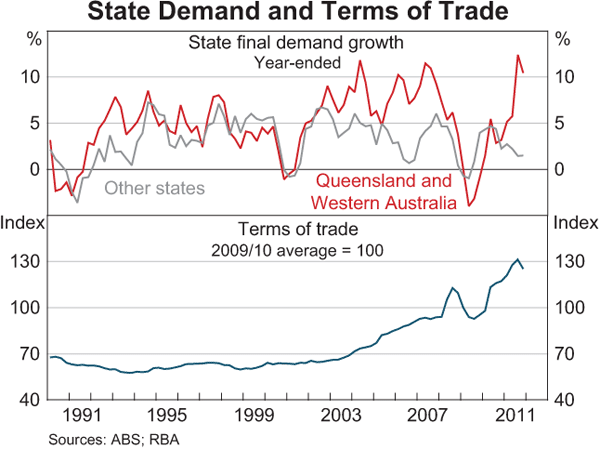
Investment spending by the business sector has made a large contribution to growth in total spending in the resource-rich states (Graph 2). Strong growth in global energy demand and high commodity prices have driven a sharp increase in Australia's terms of trade (the ratio of export prices to import prices). This has resulted in an increase in resource investment, especially in the liquefied natural gas (LNG), iron ore and coal industries. In 2011, business investment in the resource-rich states was exceptionally strong, increasing by 28 per cent in Western Australia and 58 per cent in Queensland.
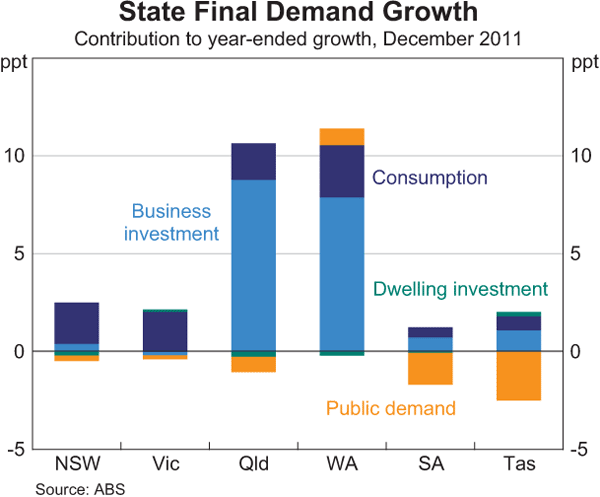
However, not all of this investment spending was used to purchase goods and services produced in the resource-rich states themselves. Mining investment is import intensive, especially for LNG projects, which have accounted for a large share of the value of recent project commencements. As a consequence, for several years capital imports have been rising at a pace roughly in line with the increase in mining investment (Graph 3).[1] In addition, the Bank's business liaison confirms that part of the mining investment (and operational) spending undertaken in Western Australia and Queensland is met by production in other states, not just for inputs such as parts but also for a range of professional services, such as accounting and consulting services. As a consequence, up until now at least, the differences in the growth of production across states has been narrower than the differences in the growth of total spending.[2]
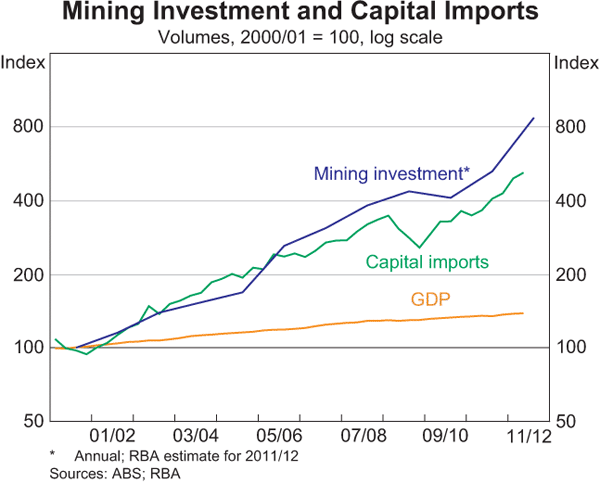
Relative to mining-related investment, the growth in non-mining investment spending has been more similar across states in recent years. Private non-residential building investment in almost all states has been relatively subdued compared with the period before the global financial crisis (Graph 4). In the office sector, the Bank's liaison suggests that construction has been constrained by the reluctance of tenants to commit to new office space and tight credit conditions for developers. Vacancy rates – a key indicator of future office investment activity – increased in all capital cities during the recent downturn, as new supply came online and tenant demand eased (Graph 5). More recently, tenant demand has increased in Perth, Brisbane and Melbourne and vacancy rates have fallen somewhat in these cities, though the vacancy rate remains relatively high in Sydney. More broadly, the recent weakness in non-mining investment reflects subdued business conditions for a range of trade-exposed firms, especially in the manufacturing, tourism and education industries. Although these industries are facing challenging conditions in all states, differences in state industry composition mean that South Australia, Tasmania and Victoria are more exposed to the weakness in the manufacturing sector, while Queensland is most affected by the softness in tourism demand (see Appendix A for the industry composition of each state).[3]
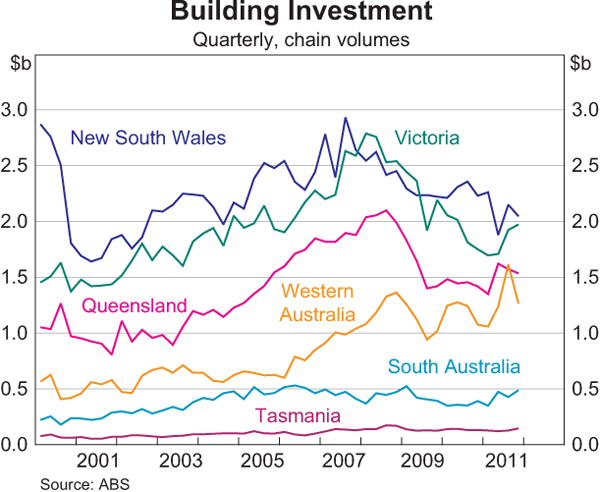
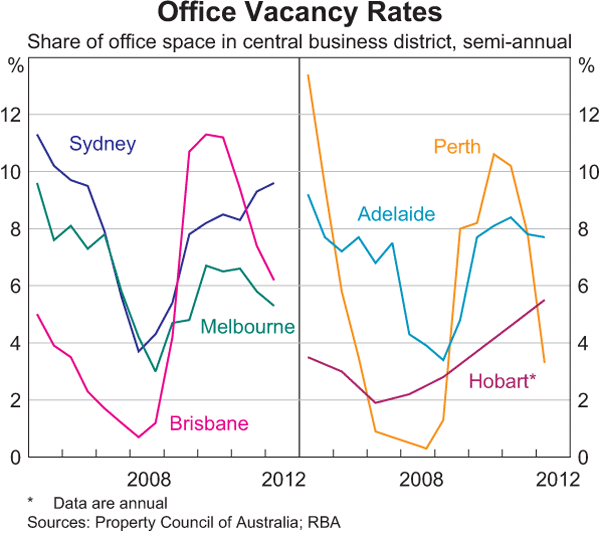
Housing market conditions have been weak in all states recently, as demonstrated by falling approvals for new dwellings and house prices (Graph 6). However, the extent of the weakness varies across states. The Queensland housing market has faced the sharpest change in conditions, with dwelling investment in 2011 around 25 per cent below its peak in 2008. Housing market conditions in Western Australia and South Australia have also softened noticeably in recent years. While dwelling construction in Victoria has been strong over recent years, particularly for inner-city apartments, recent data on approvals suggest that dwelling construction is likely to ease in the period ahead. A number of common factors are weighing on housing investment spending in all states, including the earlier pull-forward of demand from the temporary increase in first home buyer grants, slower population growth, tight access to credit for developers, lower expectations of capital gains and general household caution.
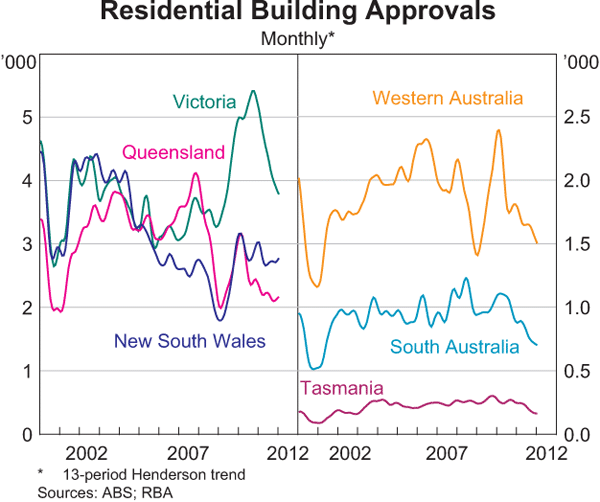
There are some differences in the recent pace of household consumption spending across states. Consumption growth in Western Australia has outpaced that in other states (Graph 7). This was partly due to stronger population growth in Western Australia than in other states, driven by a pick-up in both overseas and interstate migration in response to firmer labour market conditions (Graph 8). Nonetheless, the stronger labour market and associated income growth in Western Australia has contributed to solid growth in consumption even in per capita terms. In the eastern states, consumer spending grew at an around trend pace over the past year; consumption growth was noticeably weaker in South Australia and Tasmania.
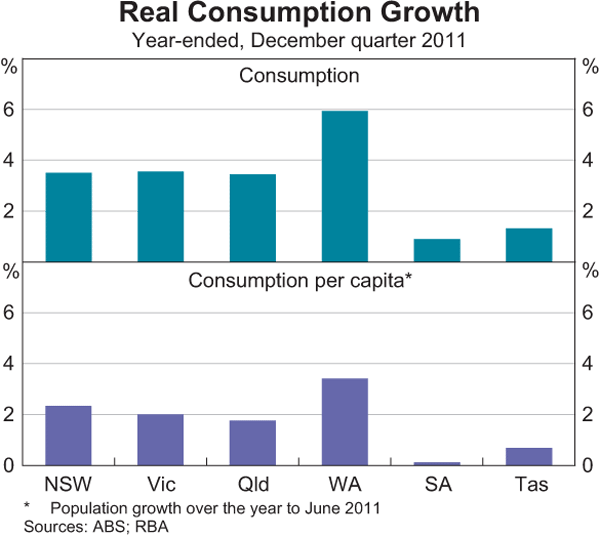

Measures of Overall State Economic Activity
There are a number of different indicators that provide a comprehensive picture of economic activity at a state level. Gross state product (GSP) measures the level of state production by adjusting spending for both interstate and overseas trade. However, GSP is published only annually; the most recent data are for 2010/11, which is before the surge in mining investment in the second half of 2011. Nevertheless, the GSP data indicate that while production in Western Australia and Queensland has grown faster than in the other states since the onset of the resources boom in the mid 2000s, the differences have narrowed markedly in recent years (Graph 9).[4] As noted earlier, dispersion in state production is much less pronounced than in state spending, since much of the inputs used in mining investment in the resource-rich states are drawn from overseas and from the other states. It is also likely to reflect income transfers across the country, through, for instance, tax payments, dividend distributions and wages paid to fly-in fly-out workers from other states (for more details, see Stevens (2010) and Connolly and Orsmond (2011)).
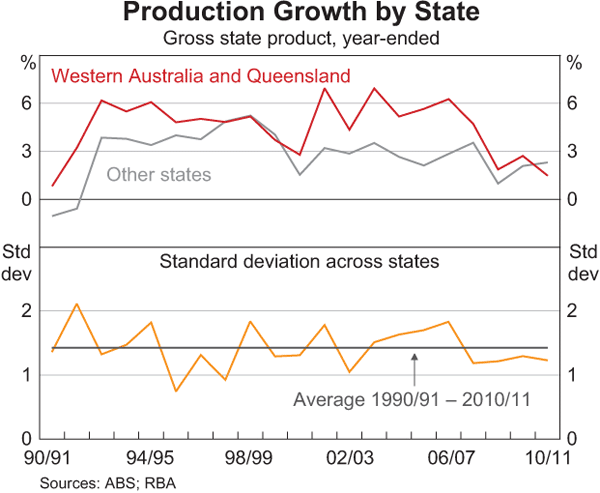
Although the strength of employment growth differs across states, the variation between state unemployment rates has been low by historical standards over recent years. In terms of labour demand, the job vacancy rate in both Western Australia and Queensland has continued to rise over recent years, while it has remained broadly stable in the other states (Graph 10). In part, this reflects rapid growth in vacancies in the mining industry and in firms servicing the mining industry. Western Australia has the tightest labour market – as it has for much of the past decade – and it currently has a trend unemployment rate of around 4¼ per cent. Queensland has the second highest unemployment rate among the states at around 5½ per cent in trend terms (Graph 11). Tasmania has the highest trend unemployment rate at around 6½ per cent, having increased sharply over the past year. Despite these differences, the divergence between state unemployment rates has been below its long-run average (Graph 12).
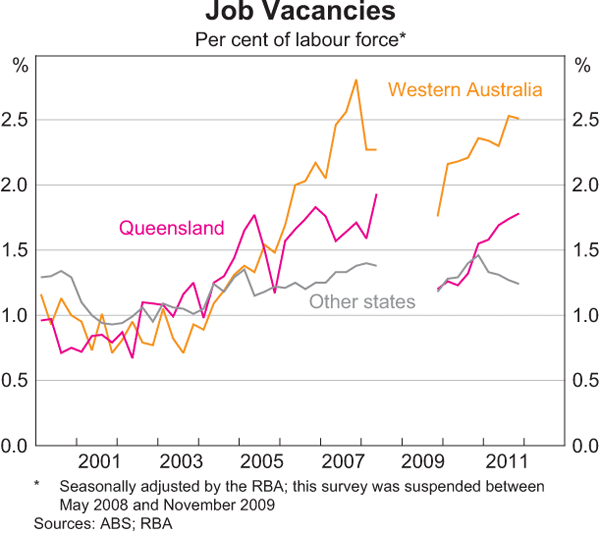

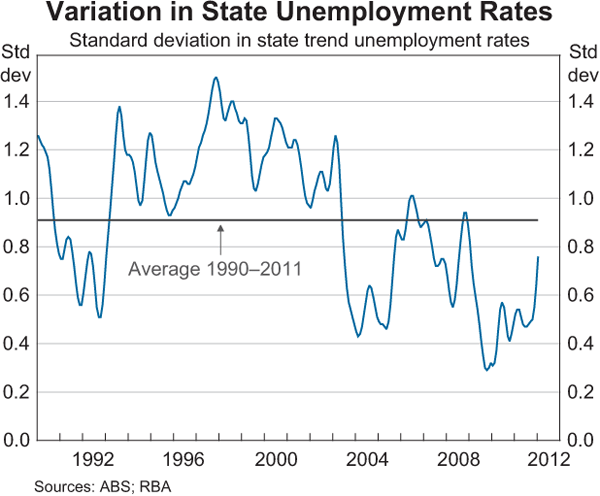
Notwithstanding significant differences in the pace of spending across states, developments in consumer price inflation remain highly correlated across capital cities. This is not surprising given the common effect of the exchange rate appreciation on prices in all states and the fact that goods and labour can move across state borders in response to any significant differences in relative prices or wages. In most capital cities, consumer price inflation eased in the past year, although inflation was broadly stable in Perth (Graph 13). In 2011, inflation was highest in Adelaide and softest in Perth and Brisbane; however, the range between the highest and lowest inflation rates was only 1.2 percentage points.
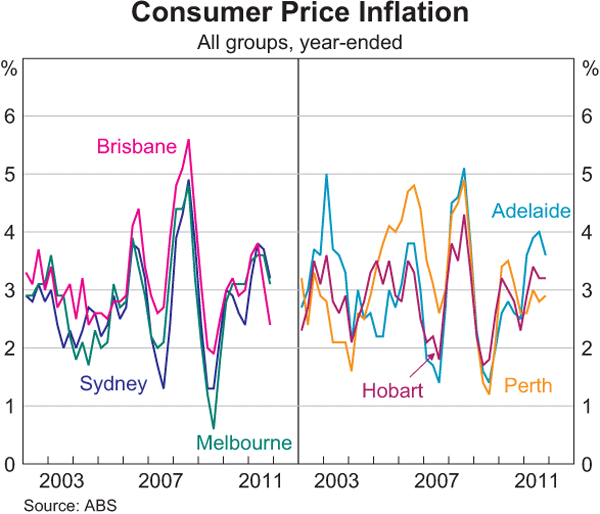
Conclusion
Strong growth in mining investment in the resource-rich states is largely responsible for recent differences in the pace of growth of spending across states. This investment is helping to support employment and household incomes, which has helped to underpin growth in household spending, especially in Western Australia. In Queensland the overall impact of the growth in mining investment is less than in Western Australia, as its economy is less resource intensive and more exposed to weakness in the tourism and housing construction sectors. The pace of activity in the non-mining industries has been more uniform across states, and the dispersion between states in terms of production growth, unemployment rates and inflation has been relatively low. In part, this reflects that, over time, the benefits of mining investment and exports flow across the country through spending by mining-related firms and workers on goods and services in other states, dividend payments to shareholders, and the tax and transfer system.
Appendix A: Indicators of State Size, Growth and Industry Composition
New South Wales currently accounts for almost one-third of national production, population and employment, and Victoria accounts for around one-quarter of these variables (Table A1). Consequently, economic conditions in the two largest state economies have a significant influence on national averages. Average annual rates of growth in real production have been higher in Queensland and Western Australia over the past two decades, and as a consequence the relative size of these states has increased significantly (Table A2).
In addition to variation in their size and growth rates, states vary in their industry structure (Table A3). New South Wales and Victoria have a disproportionate share of business services activity, reflecting the positions of Sydney and Melbourne as large business and financial centres. Victoria is also characterised by an above-average share of manufacturing. Western Australia and Queensland have the largest mining industries. In South Australia and Tasmania, agriculture and manufacturing account for higher shares of production than the national average.
| NSW | Vic | Qld | WA | SA | Tas | |
|---|---|---|---|---|---|---|
| GSP share | 31.3 | 22.6 | 19.0 | 15.5 | 6.4 | 1.8 |
| Population share(a) | 32.3 | 24.9 | 20.3 | 10.4 | 7.3 | 2.3 |
| Employment share(a) | 31.3 | 25.4 | 20.4 | 10.8 | 7.2 | 2.1 |
| Exports share(b) | 20.6 | 11.4 | 19.6 | 40.1 | 4.5 | 1.2 |
|
(a) At end June 2011 Source: ABS |
||||||
| NSW | Vic | Qld | WA | SA | Tas | Australia | |
|---|---|---|---|---|---|---|---|
| Since 1989/90 | 2.6 | 3.0 | 4.2 | 4.3 | 2.4 | 2.1 | 3.1 |
| 1989/90–2000/01 | 3.1 | 2.9 | 4.2 | 4.0 | 2.2 | 1.8 | 3.2 |
| 2000/01–2010/11 | 2.0 | 3.1 | 4.2 | 4.6 | 2.7 | 2.5 | 3.1 |
| Per capita | |||||||
| Since 1989/90 | 1.5 | 1.8 | 1.9 | 2.5 | 1.7 | 1.6 | 1.8 |
| 1989/90–2000/01 | 2.0 | 2.0 | 2.1 | 2.5 | 1.7 | 1.5 | 2.0 |
| 2000/01–2010/11 | 1.0 | 1.5 | 1.7 | 2.5 | 1.8 | 1.7 | 1.5 |
|
Source: ABS |
|||||||
| NSW | Vic | Qld | WA | SA | Tas | Australia | |
|---|---|---|---|---|---|---|---|
| Agriculture, forestry and fishing | 2 | 3 | 3 | 2 | 6 | 8 | 3 |
| Mining | 3 | 2 | 9 | 33 | 4 | 1 | 9 |
| Manufacturing | 8 | 9 | 8 | 5 | 9 | 9 | 8 |
| Electricity, gas, water and waste services | 2 | 2 | 2 | 2 | 3 | 4 | 2 |
| Construction | 5 | 6 | 8 | 12 | 7 | 6 | 7 |
| Wholesale trade | 4 | 4 | 5 | 3 | 4 | 3 | 4 |
| Retail trade | 4 | 5 | 5 | 3 | 5 | 5 | 4 |
| Transport, postal and warehousing | 5 | 5 | 6 | 5 | 5 | 6 | 5 |
| Public administration and safety | 4 | 4 | 5 | 3 | 5 | 6 | 5 |
| Business services | 30 | 28 | 18 | 14 | 19 | 17 | 23 |
| Information media and telecommunications | 4 | 3 | 2 | 1 | 3 | 2 | 3 |
| Financial and insurance services | 14 | 12 | 6 | 4 | 8 | 8 | 10 |
| Rental, hiring and real estate services | 2 | 2 | 2 | 1 | 2 | 1 | 2 |
| Professional, scientific and technical services | 7 | 7 | 5 | 5 | 5 | 3 | 6 |
| Administrative and support services | 3 | 3 | 2 | 2 | 2 | 2 | 2 |
| Household services | 16 | 16 | 15 | 9 | 16 | 20 | 15 |
| Accommodation and food services | 3 | 2 | 2 | 1 | 2 | 3 | 2 |
| Education and training | 4 | 5 | 4 | 3 | 5 | 6 | 4 |
| Health care and social assistance | 6 | 6 | 6 | 4 | 7 | 8 | 6 |
| Arts and recreation services | 1 | 1 | 1 | 0 | 1 | 1 | 1 |
| Other services | 2 | 2 | 2 | 1 | 2 | 2 | 2 |
| Other(b) | 17 | 17 | 15 | 10 | 16 | 15 | 15 |
|
(a) Nominal industry gross valued added as a share of gross state product Source: ABS |
|||||||
Footnotes
The authors are from Economic Analysis Department. [*]
While the import share varies significantly project by project, the available data suggest that roughly half of current mining investment spending is imported (Connolly and Orsmond 2011). [1]
Production is defined here as gross state product and is equal to the sum of spending by the household, business and government sectors, plus inventories and interstate and overseas exports, minus interstate and overseas imports. Therefore, production is a comprehensive measure of the economic activity occurring within a state. [2]
For details on the recent performance of the tourism industry, see Hooper and van Zyl (2011), and for a discussion of the relationship between industry composition and regional economic performance, see Cunningham and Davis (2011). [3]
Production was particularly weak in Queensland in 2010/11 due to the impact of flooding on coal exports. [4]
References
Connolly E and D Orsmond (2011), ‘The Mining Industry: From Bust to Boom’, RBA Research Discussion Paper No 2011-08.
Cunningham M and K Davis (2011), ‘Labour Market Outcomes in Regional Australia’, RBA Bulletin, September, pp 1–8.
Hooper K and M van Zyl (2011), ‘Australia's Tourism Industry’, RBA Bulletin, December, pp 23–32.
Stevens G (2010), ‘Monetary Policy and the Regions ’, RBA Bulletin, December, pp 83–90.